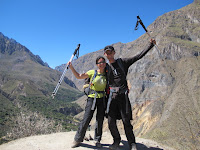Nous avons longuement étudié les options pour se rendre au Machu Pichu. Il était hors de question que nous prenions le train de la compagnie Orient Express qui est hors de prix et dont les bénéfices vont en Europe et aux États-Unis.
Il nous restait alors 3 solutions :
- faire 8h de bus jusqu'à Santa Teresa et marcher 3h le long de la voie ferrée jusqu'à Aguas Calientes (l'option la moins chère)
- s'inscrire au Jungle Trek qui consiste en 1 jour de VTT et 2 jours de marche
- s'inscrire au Salkantay Trek qui consiste en 4 jours de marche et les nuits en tente.
On a choisi la dernière option. C'est la plus dure physiquement mais on est récompensés par les paysages sublimes et l'impression d'avoir mérité le Machu Pichu le dernier jour.
Les 2 premiers jours, les plus difficiles, nous marchons 40km, atteignons un col à 4600m en pleine montagne et redescendons à 2900m dans la jungle; les paysages sont vraiment très diversifiés. Le troisième jour, on relaxe tout l'après-midi dans les sources chaudes, c'est un vrai plaisir! Au total nous avons marché plus de 60km sur 5 jours.
Nous étions un excellent groupe de 13 personnes en plus de notre guide Elias et notre cuisinier surnommé Soldado : 4 Français (Elodie, Emilien et nous), 2 Québécois (Johnattan et Melanie), 2 Brésiliens (Cayo et Victor), 1 Allemand (Maximilien), 2 Suédois (Pat et Daniel) et 2 Uruguayens.
Comme vous pouvez vous en douter, le groupe des francophones était très soudé et nous avons mis une ambiance de feu lors de la soirée en camping à Santa Teresa.
Si vous souhaitez faire la Salkantay Trek, commandez-le à Cusco. Nous avions difficilement trouvé à moins de 500$US par personne sur internet et ça nous a couté 190$US sur place !!! N'écoutez pas les arguments qui disent que c'est moins bien quand on paie moins cher, dans un même groupe certains avaient payé 450$US et d'autres 200$US pour le même service. Notre cuisinier était vraiment talentueux et nous préparait d'excellents repas.
Prochain article : le Machu Pichu.
-----------------------------------------------------------------------------
We have thoroughly studied all the options to get to Machu Pichu. There was no way we took the train company Orient Express, which is overpriced and whose profits go to Europe and the United States.
We still had three solutions:
- 8h of bus to Santa Teresa and then walk 3h along the railway to Aguas Calientes (the cheapest option)
- Join the Jungle Trek which consists of one day biking and two days walking
- Join the Salkantay Trek which consists of 4 days walking and sleeping in tents.
We chose the last option. This is the hardest but we are rewarded with breathtaking scenery and the feeling of having earned the Machu Picchu on the last day.
The first 2 days, the most difficult ones, we walked 40km, reach a pass at 4600m in the mountains and descend to 2900m in the jungle; landscapes are very diverse.
The third day, we could relax all the afternoon in the hot springs, it was a real pleasure!
In total we walked more than 60km in 5 days.
We were part of a great group of 13 people plus our guide Elias and our cook nicknamed Soldado: 4 French (Elodie, Emilien and us), two Québécois ( Melanie and Johnattan), two Brazilians (Cayo and Victor), a German (Maximilian ), two Swedish (Pat and Daniel) and two Uruguayans.
As you might expect, the group of French speakers was very united and we had great fun during the party in Santa Teresa.
If you want to do the Salkantay Trek, order it to Cusco. It was difficult to find it for less than 500$US per person on the internet and it cost us 190$US on the spot! Do not listen to the arguments that say the service is bad when you pay less, in the same group some persons had paid 450$US and others 200$US for exactly the same service. Moreover, our cook was really talented and prepared us excellent meals.
Next Article: Machu Pichu.































































